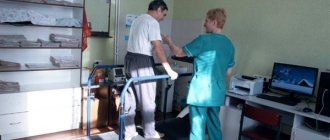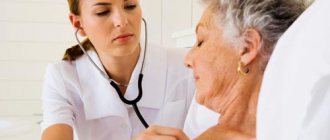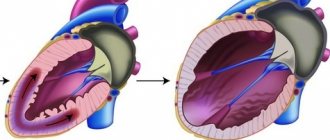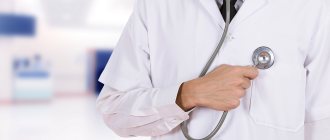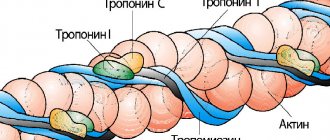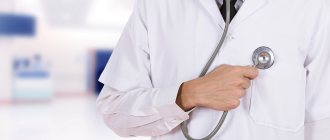Author Andrey Belyakov
03/12/2008 10:36 (Updated: 08/20/2021 12:19)
Health » Health and prevention
The vast majority of heart attack survivors can safely return to driving. In some cases, having your own car turns out to be not only not harmful, but also extremely useful. Agree, it’s one thing to get to work on foot or jostled in public transport, and quite another thing to drive calmly in your own car. But just really calm.
What post-infarction indicators affect the ability to drive?
The brain processes information slowly at first. A person’s speed of perception and reaction decreases, which prevents him from reacting to a traffic situation in a timely manner. An extensive infarction leads to the formation of multiple scars that impair the contractile function of the muscle. This often provokes loss of consciousness or repeated attacks.
List of evaluation criteria that do not allow you to drive independently:
- unstable psycho-emotional state;
- physical weakness and slow recovery rate;
- the myocardium was severely damaged as a result of circulatory disorders;
- there is arrhythmia or tachycardia.
The presence of one of these indicators (and they appear in absolutely everyone at first) prevents a person from driving in person. Until his condition stabilizes, he is advised to move around in another way for his own safety. If the evaluation criteria meet the restoration standards, the motorist can obtain permission to drive land vehicles.
When the heart and nervous system are so strong that a person feels comfortable behind the wheel, doctors allow him to drive a car. This is included in the recovery plan, since when moving by transport, the cardio system is not loaded as much as when walking.
But is it possible to work as a driver after a heart attack? There are laws in the Russian Federation that prohibit engaging in this type of activity. The director, based on the conclusion of the VTEK and the person’s application, provides him with a position not related to driving.
In what cases can you return to driving?
According to many doctors, returning to driving after a heart attack is one of the stages of rehabilitation. But they allow access to the steering wheel only if a person’s confidence in this desire is beyond doubt, and the condition of his heart after the damage caused by a heart attack allows him to experience the stress associated with the process of driving.
It is important in this regard that the patient should not have anxiety, irritation, or fear; he should be comfortable behind the wheel. It will also be mandatory to undergo all necessary examinations in order to provide the attending physician with the information necessary to analyze the patient’s condition.
The approximate period that doctors call normal for returning to driving a vehicle after a heart attack is two months. It is this amount of time, from a medical point of view, that is enough to gain confidence in one’s state of health, taking into account the completion of all necessary rehabilitation measures. Here it is worth understanding that this is a conditional figure, and each individual case of myocardial infarction is considered strictly individually.
It is also necessary to consider the possible options for human movement. Walking long distances greatly exhausts the body, which significantly aggravates the pre-infarction condition. A trip on public transport can often be accompanied by negative factors: crowding, heavy flow of people in public places, an increased likelihood of stressful situations. All this is more likely to provoke a deterioration in a person’s health than driving a personal car.
When returning to driving after a heart attack, you shouldn’t drive alone for the first time - on every trip you need to take a passenger with you who can provide the necessary first aid in case of a relapse or at least is aware of the driver’s health problems and will be able to call for medical help without being confused. The car first aid kit should contain the appropriate medications (nitroglycerin and those prescribed by the attending physician), and if there is any hint of a deterioration in your health, you should refuse the planned trip.
Doctors' opinion
When you can drive after a myocardial infarction and stenting depends on the speed of recovery. General treatment predictions are that this occurs no sooner than 60 days after the attack. If a person does not have finger trembling and his psycho-emotional state has stabilized, then he is allowed to drive a car. In the presence of irritability, anxiety, tremor and other residual effects of a heart attack, driving is temporarily contraindicated.
According to doctors, moving independently by car eliminates physical and psycho-emotional stress compared to traveling by public transport or walking long distances. Therefore, in the late rehabilitation post-infarction period, you can drive a car in compliance with medical recommendations and driving principles.
Restrictions on holidays
All habits and traditions change after illness, including those related to recreation. Many patients wonder whether it is possible to go to the sea after a heart attack. In the early outpatient period, this is strictly prohibited; at the stage of sanatorium-resort treatment, it is also better to relax in your own climatic zone, without subjecting the body to the test of heat and a long road.
According to doctors' recommendations, swimming in open water is only possible 7-8 months after a heart attack. By this time, the sutures on the sternum have healed, reducing the risk of an angina attack and changes in heart rate. It is forbidden to organize swims, it is forbidden to dive or engage in diving.
At the same time, moderate swimming in the pool provides a beneficial exercise for the heart.
Stages of the therapeutic swimming cycle:
- Preparatory: breathing exercises and procedures (rubbing, dousing, foot baths).
- Basic: at a water temperature of +26°C and air temperature of +24°C, you can swim in an open pond or pool for 15-20 minutes.
- Final: carried out in water with a gradual decrease in load.
Another important issue is related to possible flights to a vacation spot. Flying on an airplane is not advisable after a heart attack and stenting, but it is not prohibited.
A number of restrictions apply here:
- do not fly earlier than six months after a severe heart attack and two weeks after an uncomplicated one;
- obtain a consultation from the attending physician and a statement about the treatment of the heart attack and the condition after it;
- before takeoff, place a Validol tablet under your tongue;
- if you feel anxious or nervous, take a sedative;
- during a long flight, periodically get up from your seat and walk around the cabin for normal hemodynamics.
It is strictly prohibited to use aviation services in case of heart failure not corrected by medications, severe arrhythmia, persistent arterial hypertension, or unstable angina.
Driving rules after a heart attack
You need to constantly monitor your well-being and health in general. Immediately before operating the machine, you need to measure your heart rate, pulse, blood pressure, and make sure that there are no failures in coordination of movements, dizziness, or blurred vision.
If your health worsens:
- before the trip - they refuse to drive;
- while driving, stop the car and press the emergency signal button.
In both cases, you need to take the medicine immediately. Nitroglycerin and other prescribed medications must be carried with you, regardless of the method or distance of movement.
Medical requirements for driving after myocardial infarction:
- Immediately after admission, it is prohibited to drive a vehicle alone. For the first 1.5-2 months, they take a passenger in case of a sudden deterioration in health.
- It is forbidden to travel far. Initially, you are allowed to drive on an uncongested road for 5-10 minutes. The duration is increased gradually, but you cannot move long distances. This will prevent overwork and reduce the risk of another attack.
- To exclude a relapse due to worries about being late for work, you can switch to a variable schedule by presenting the director with a certificate from the VKK.
- It is not recommended for drivers to travel during rush hour. Driving on a busy road increases nervous tension, which increases the risk of relapse.
Mandatory requirement for driving after a heart attack: always carry Nitroglycerin with you. If you feel worse, you need to turn on the alarm, stop and take medicine. Then call an ambulance.
conclusions
The adequacy of physical activity and restrictions in rest is determined and assessed by the doctor in the process of dispensary observation of the patient. In any case, returning to a normal lifestyle will take at least a year after a heart attack.
When expanding activity, a comprehensive examination of the patient is carried out to determine coronary reserve and exercise tolerance. Speed running, weightlifting and lifting weights are contraindicated for life. But you can drive a car after a heart attack.
Risks
At first, it is difficult for a person after a heart attack to simultaneously focus on following traffic rules and listen to his own well-being. And the status of domestic roads and the behavior of some ill-mannered drivers or pedestrians adversely affect his psycho-emotional state. Therefore, during each trip, a relapse of the disease may occur.
Repeated heart attack or loss of consciousness while driving can cause an accident. As a result of an accident, both the driver himself, the drivers of the affected cars, or bystanders can die or become disabled. Therefore, driving in the post-infarction period is always dangerous.
Is it possible to drive a car after a heart attack? VKEC specialists decide. Loss of control over the car ends in an accident and poses a threat to the lives of all road users. A person with arrhythmia and the presence of a syndrome accompanied by frequent loss of consciousness should not drive. Such people will not be able to renew their driving record during the next medical examination or, if necessary, to restore their license.
When should you not drive after a stroke?
After a stroke, a general ban on driving is imposed for a period of 3-6 months. Next, the medical commission, guided by the degree of damage and severity of the disease, after studying all the complications that have developed, will make a decision on the possibility of driving. For example, if the field of view decreases by more than 20 degrees, the medical commission will not give permission to drive a car.
As a result of a stroke, the human psyche often suffers. There may be sudden mood swings, depression, and the inability to adequately assess the situation and make quick and correct decisions. Moreover, almost all drugs used to correct mental problems are contraindicated when driving a car.
Complications such as partial paralysis or muscle spasticity are also a complete contraindication to driving.
Sometimes epilepsy develops after blood circulation in the brain is disrupted. In this case, it is impossible to drive the car.
Question answer
What form of medical certificate is needed when replacing a driver's license?
What does the law say?
Can a person drive a car after a myocardial infarction? It is prohibited to do this professionally, which was approved by Order No. 302N dated April 12, 2011. The car may become uncontrollable and an accident may occur with possible death of participants in the traffic accident or third parties.
In the post-infarction period, the driver is assigned disability group III. He is assigned a state benefit and given light physical work. But he can drive his own transport, since motorists are allowed to drive in the absence of complications of the disease.
I have only myself to blame
According to Judge Oleg Zatelepin of the Supreme Court of the Russian Federation, the need to develop this document is caused by the age of the previous similar act, issued 27 years ago. The new resolution will summarize judicial practice in criminal cases regarding violations of labor protection requirements and safety rules during construction and other work or industrial safety requirements of hazardous industries.
According to the data presented at the meeting, more than 1.7 thousand people died in the workplace last year. However, 24 percent of deaths were recorded in the construction industry. People also often die in manufacturing, agriculture, hunting and fishing. Mining industry comes in last place with 8 percent of accidents.
The judges also explained the need to develop a new resolution by the recent entry into force of amendments to the Criminal Code of the Russian Federation, which tighten liability for incidents at hazardous production facilities. According to changes to the Code, those found guilty of causing grievous harm to human health or major damage face a fine of up to 400 thousand rubles or imprisonment of up to 3 years.
As noted in the draft resolution of the plenum of the Supreme Court, when considering each case under Article 143 of the Criminal Code of the Russian Federation “Violation of labor protection requirements”, Article 216 “Violation of safety rules during construction or other work” or Article 217 “Violation of industrial safety requirements of hazardous production facilities” not only the fact of violation of special rules, but also the presence or absence of a causal relationship between these violations and the resulting consequences must be established and proven.
“If an industrial accident occurred only as a result of the negligent behavior of the victim himself, the court must, if there are grounds for this, decide on the issue of an acquittal,” the draft resolution notes.
And a very important amendment - victims in criminal cases can be not only employees with whom employment contracts were concluded in the prescribed manner, but also persons with whom the contract was not concluded or was not properly executed, but the employee began work with the knowledge or on behalf of employer.
If the incident occurred solely due to the negligent behavior of the employee, the court must take this into account and acquit the employer
The document establishes that liability under Article 143 lies with the employees of the company in which the accident occurred, as well as employees of the labor protection service. Managers of an organization can also be prosecuted under this article, but only if they did not take measures to eliminate violations of labor safety requirements known to them or gave instructions that contradict such requirements. Article 143 of the Criminal Code of the Russian Federation provides for punishment in the form of imprisonment for up to 5 years.
Following the discussion, the Chairman of the Supreme Court, Vyacheslav Lebedev, sent the draft resolution for revision.
“This project preserves the most important and still relevant provisions that were in the previous resolution, and also systematizes and adapts the existing practice over all this time,” notes lawyer Ruslan Mannapov. — It is especially worth noting that the document contains provisions on the possibility of reference in a court decision not only to the violated rule of law, but also to local regulations in force at the employer. He also mentions industrial accidents when performing work under a civil contract.
“The problems that exist in this area of law are more serious and broader; the number of accidents is much higher than the officially announced statistics,” notes lawyer Irina Fast. — The main problem is the resolution of criminal cases in relation to accidents involving workers who were not employed or were registered through civil legal relations with third parties.
Investigation of such cases is not carried out by the labor inspectorate due to the lack of labor relations. And this is a serious problem at all construction sites in the country. “Each time, in order to obtain a result, the victim is forced to first establish through the court the fact of the existence of an employment relationship with a particular company, and only then seek any responsibility for what happened for the guilty persons from among the employers,” notes Irina Fast.
How to speed up rehabilitation?
To prevent relapse and facilitate recovery, doctors may suggest coronary stenting. The minimally invasive operation is performed under local anesthesia. The surgeon inserts a stent into the femoral artery through a catheter. Then, along its channel, the device is brought to the place of narrowing. After installing the tube, the vessel wall expands along the perimeter of the lumen, which ensures normal blood circulation.
| Actions of the patient after a heart attack and/or stenting during the rehabilitation period | |
| What speeds up recovery | What must be done |
| Unquestioning adherence to all medical recommendations. | Gradually increase physical activity. |
| Rest in a sanatorium that specializes in cardiovascular diseases. | Do not lift loads exceeding 3 kg. |
| Transfer to a position with favorable working conditions. | They walk for 5-60 minutes every day, accompanied by a relative. |
| Hobby: listening to your favorite music. | Follow diet No. 10 according to Pevzner. |
| Psychologist consultations. | Avoid overwork and nervous tension. |
| Normalization of weight and cholesterol levels | They continue to take medications. |
| Quitting smoking and other bad habits. | See a cardiologist. |
A man or woman should “weed out” intimidating information about the way of life after a heart attack. At what stage of rehabilitation you can start working, driving a car, having sex and other information should only be obtained from the attending physician, who knows all the individual indicators and dynamics of rehabilitation.
Life after a heart attack
Myocardial infarction is the acute and most severe form of coronary heart disease, in which a section of the heart muscle dies as a result of blockage of the coronary artery that supplies it with blood. As a rule, this occurs as a result of rupture of an atherosclerotic plaque located in the artery wall and the development of acute thrombosis. Less commonly, severe spasm of the coronary artery leads to cessation of blood flow. Often there is a combination of both mechanisms.
What should change in the life of a person who has suffered this illness? What do you need to know about yourself and the disease in order to have a good quality of life, not become a burden to your family, and return to your profession?
Currently available methods of rehabilitation (restorative treatment) of patients after myocardial infarction can be combined into two groups: non-pharmacological and medicinal.
What are non-drug treatments?
First of all, this is a change in lifestyle, a change in lifestyle, including:
1. Stop smoking. Quitting smoking for two years reduces the risk of coronary death by 36%.
Often, patients who have suffered a myocardial infarction, experienced the fear of death, or been through intensive care units, quit smoking overnight, telling the doctor and each other how easy it was for them to do it.
Others need support to quit smoking. You need to explain to friends and family why you decided to quit smoking. At a minimum, you need to ask others not to smoke in your presence. In some cases, nicotine replacement therapy will be required.
Experienced smokers should know that quitting smoking leads to increased appetite and weight gain. Therefore, stopping smoking should be accompanied by streamlining food intake (not passing, not eating two hours before bedtime) and increasing physical activity.
2. Normalization of body weight. To assess the correspondence between weight and height, the body mass index is used. In order to calculate your body mass index (BMI), you need to divide your weight in kilograms by your height in meters, squared, according to the formula:
BMI= weight (kg)/height² (m²)
Normal index values are 20-25 kg/m². An increase in the index to 25-30 kg/m² indicates the presence of excess body weight, more than 30 kg/m² - obesity. You should not lose weight if it is within normal limits.
3. Changing the nature of nutrition. The main goal of the diet is to reduce cholesterol and other atherogenic blood lipids while maintaining the physiological completeness of the diet.
It is necessary to give preference to a diet low in saturated fat and cholesterol, with sufficient amounts of vegetables, fruits, and grain products that will provide the body with essential vitamins, minerals, fiber (fiber) and complex carbohydrates.
You need to know the basic principles of nutrition:
- Regular consumption of a variety of vegetables and fruits - at least 400 g or 5 servings per day. One serving is equal to 1 apple/1 banana/1 orange/1 pear/2 kiwi/2 plums/1 tablespoon dried fruit/1 large slice of melon or pineapple/1 glass of juice. The amount of boiled or fresh vegetables should be at least 400 grams (2 cups).
- Moderate consumption of dairy products: skim (skim - 0.5-1% fat) milk, low (20%) fat cheeses, low-fat cottage cheese, yoghurts, buttermilk.
- Give preference to fish, including fatty fish (cod, haddock, flounder, herring, sardine, tuna, salmon) over meat products. Fish should be present in the diet at least 2-3 times a week.
- From meat products, choose lean meat without streaks of fat: turkey, chicken, veal, game, rabbit, young lamb. It is advisable to remove the skin from the bird.
- Consume no more than 2-3 eggs per week. Limit your consumption of yolks, but you don’t have to limit your consumption of egg whites.
- Recommended seasonings: pepper, mustard, spices.
- Recommended drinks: tea, black coffee, water, sugar-free soft drinks.
- Nuts: walnuts, almonds.
- Consume sugar only in moderation, reduce your salt intake to less than 5 grams per day.
- Limit the consumption of alcoholic beverages to less than 30 grams of pure alcohol for men and 20 grams for women per day. The doctor can recommend taking moderate doses of alcohol to the patient, being sure that his patient will not exceed the following doses: strong alcoholic drinks 45-50 ml per day, dry wine (preferably red) 100-200 ml per day. For women, these doses should be reduced by one third.
- New cooking methods need to be tried: ones that are low in saturated fat. It is recommended to replace animal fat with vegetable oil (sunflower, corn, cottonseed, olive, flaxseed, soybean).
A balanced diet should be combined with systematic physical training and household activities. Under the influence of moderate-intensity physical training, there was a reduction in overall mortality by 23% and sudden death by 37% in patients who had previously suffered a myocardial infarction.
For patients after myocardial infarction, the training load regimen is selected strictly individually, taking into account the results of the physical load test (treadmill test, bicycle ergometry). Depending on the functional state of the cardiovascular system and the clinical manifestations of the disease, different amounts of physical activity are recommended.
Before starting exercise therapy, talk to your doctor! You need to know that along with the positive effect, inadequate physical activity can lead to the development of severe complications during the course of the disease.
Remember the following tips:
- Be sure to attend physical therapy classes during your stay in the cardiology department of a hospital, inpatient rehabilitation department, and in outpatient clinics (cardiology center, clinic). The purpose of these classes is not so much to teach the basic sets of physical exercises, but to teach methods of monitoring your condition during physical training, so that in the future you can exercise independently.
- It is necessary to choose accessible and familiar types of physical activity, such as walking, swimming, cycling, in which you could move at a uniform speed. Walking is an excellent form of physical activity. You don't need any special equipment or equipment other than a pair of good shoes. You should start with short walks at a moderate pace (up to 90 steps per minute), gradually increasing the time to 30-40 minutes with short-term (2-3 minutes) periods of acceleration.
- Remember three words: “moderately”, “long-term” and “regularly”. Moderate physical activity, lasting at least 30-40 minutes, including warm-up and “cooling down” periods, regularly at least three to four times a week, has a beneficial effect on the functioning of the heart and blood vessels. If you cannot devote 30 minutes to exercise without a break, you can devote 10 minutes to it and do it three times a day, which will also give positive results.
- Physical activity also includes household activities: housekeeping, seasonal work in the garden or vegetable garden, walking up the stairs instead of using the elevator, walking to work and home.
- It is impossible to give a single recommendation for all patients regarding the timing of resumption of sexual activity. In the vast majority of cases, this is one to one and a half months from the date of the heart attack. It is known for sure that if a patient performs a power level of 100 W (600 kg/m) for one minute or more during a stress test, sexual activity does not require restrictions. Do not hesitate to ask your doctor any question you are interested in.
A patient who has suffered a myocardial infarction must know and control his blood pressure level. Blood pressure should be measured after being at rest for 5 minutes. Initially, it is necessary to measure the pressure in both hands. Subsequently, control is carried out on the hand, where the pressure is higher. When using manual tonometers, the degree of air inflation in the cuff is determined by the disappearance of the pulse in the radial artery, after which the pressure additionally increases by 10-15 mmHg. The rate of air removal from the cuff is 2 mm per second. Pressure must be measured with an accuracy of 2 mmHg. When using semi-automatic or automatic devices, the measurement is carried out in accordance with the attached instructions. Several measurements are taken at intervals of 1-2 minutes until stable blood pressure levels are obtained.
Blood pressure in a patient who has suffered a myocardial infarction should be 130/80 mmHg or less.
What are the general rules for drug treatment of coronary heart disease?
The first and basic rule is the rule of constant use of medications. “And the best medicine will not help the patient if he refuses to take it.” Cervantes (1547 - 1616).
The second rule is the rule of combination therapy.
Myocardial infarction is an acute form of a chronic disease. Unfortunately, even with the most favorable outcome, complete recovery does not occur. Patients who have suffered a myocardial infarction are simultaneously prescribed several drugs with different mechanisms of action. At a minimum, they must take three medications that improve the prognosis of the disease (“ABC rule” - according to the first letters in the name of the drug groups).
Acetylsalicylic acid has the property of reducing the formation of blood clots in the heart and blood vessels and is the basis for the prevention of arterial thrombosis. Regular use of acetylsalicylic acid reduces the risk of recurrent myocardial infarction by an average of 23%. If you are intolerant to acetylsalicylic acid, your doctor will prescribe you other drugs that prevent blood clots.
Beta blockers interrupt the signals the body sends to the heart during exercise and emotional stress. They seem to protect the heart from the need to use large amounts of oxygen, transfer it to an “economical operating mode” and thereby preserve its performance. Beta blockers reduce the risk of sudden death, recurrent myocardial infarction and increase the life expectancy of patients who have had a myocardial infarction.
Statins are drugs that lower blood cholesterol levels, are safe for long-term use, are well tolerated by most patients, and reduce the risk of atherosclerotic cardiovascular complications.
In severe cases of coronary heart disease, if the patient has arterial hypertension, diabetes mellitus, or other concomitant diseases, the number of medications taken can and should be increased.
Changing your lifestyle means changing your rules and habits.
- Start your morning so that you have time to have a quiet breakfast and take your medications. Some medications (such as nitrates) should be taken 20-30 minutes before leaving home.
- Leave the house early so that you can stand at the entrance for a few minutes, especially in the cold season. Sometimes breathing in frosty, unusually cold air, especially in combination with fast walking, can trigger an angina attack.
- Get rid of the habit of starting walking at a fast pace. Give your heart time to get used to, adapt to the given rhythm.
- Give up the habit of rushing, running after departing vehicles as if this is the last bus (trolleybus) in your life and none of them will ever come to your stop again.
- Wherever you are (at home, at work, visiting, in the forest, at the dacha, etc.), you must have nitroglycerin (tablets, capsules, spray) with you.
- If you leave home for any period, even a short one, you need to have the necessary supply of the medications you take with you in order to feel safe and not create unnecessary problems for others.
- It is advisable that in your purse (purse, car glove compartment, etc.) there is the latest electrocardiogram that you had at your doctor’s appointment. No one knows where you may need medical help, and then the old “film” will be of good service to your doctor.
The most important rule for successful treatment is cooperation between doctor and patient.
Remember, if you don't think about your future, you may simply not have one.
What group will they give?
There are three disability groups in total, each of which is assigned to the patient if there are strict indications. The criteria that guide the commission are given below.
| Disability group | Working or not | Criteria |
| 3 group | Working | Deviations in the functioning of the heart muscle and the functioning of blood vessels are insignificant and do not affect the performance of professional duties, provided that the person was engaged in light labor or mental activity |
| 2nd group | Working (with restrictions) | The patient experiences periodic attacks of exacerbation (for example, angina), which prevent him from performing his usual work. The heart functions poorly and there is an increased risk of relapse. Transfer to light work is possible subject to periodic maintenance treatment with appropriate notes in the outpatient card |
| 1 group | Non-working | Every day the patient is diagnosed with angina attacks, suffocation and pain in the heart area. Chronic heart failure is diagnosed. Such patients cannot work |
If the patient loses the ability to serve his natural needs, the effect of the therapy used is absent and does not bring relief, and lifelong disability is issued.
Criteria for disability groups
What to do if the commission makes a negative decision?
Sometimes it happens that the commission refuses to assign a group after a heart attack. To understand how objective such a decision is, you can try to seek clarification from the chairman of the commission and, on their basis, write a second application to undergo another examination.
It will be reviewed within 72 hours. If the result is again negative, the patient can undergo a commission at the independent examination bureau or go to court. If the judicial authority satisfies the patient's demands, the commission will not be able to reverse this decision.
How soon can I start driving?
After a heart attack, you can drive a car only when your health condition is completely stabilized. The rehabilitation period can take from several weeks to a year or more. Following the recommendations of your doctor speeds up the recovery process.
When resuming driving, the patient should:
- feel consistently good;
- be able to control your emotions (a sharp reaction to what is happening is fraught with aggravation of coronary artery disease);
- have good ability to concentrate, endurance, high reaction speed;
- no episodes of dizziness, loss of consciousness, good heart condition.

